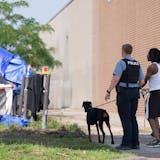Growing up in St. Paul in a family with four children, the closest Angelo Rulli got to a family vacation most years was a ride on a carousel.
“What could be better than a carousel ride for a kid?” he said. “It’s still one of my favorite memories of childhood.”
On a recent evening, a special event at Cafesjian’s Carousel in St. Paul’s Como Park attended by the 81-year-old Rulli and about a dozen other enthusiastic adults suggested that carousels aren’t just for kids.
“It’s important this magnificent machine get credited,” Rulli said.
The two-hour event in September was one of several “History in Motion” sessions held this past season, with more planned for next year. They offer an opportunity to learn about the colorful past of one of the largest surviving antique wooden merry-go-rounds in the country, one of the few that retains its original paint even after surviving a fire and other upheavals.
The program was led by Tracy Tolzmann, president of the board of Our Fair Carousel (OFC), the nonprofit that almost 40 years ago rescued the carousel from being dismantled and that is still in charge of keeping its historic horses galloping.
The carousel will close for the season on Oct. 27 but will be open on MEA weekend, Oct. 17-18.
Dispensing the first of many fun facts, Tolzmann explained that the ride has to close when temperatures drop below 45 degrees because parts of it are made from the same steel as was used in the Titanic, which of course broke and sank when the ship hit an iceberg in 1912.



